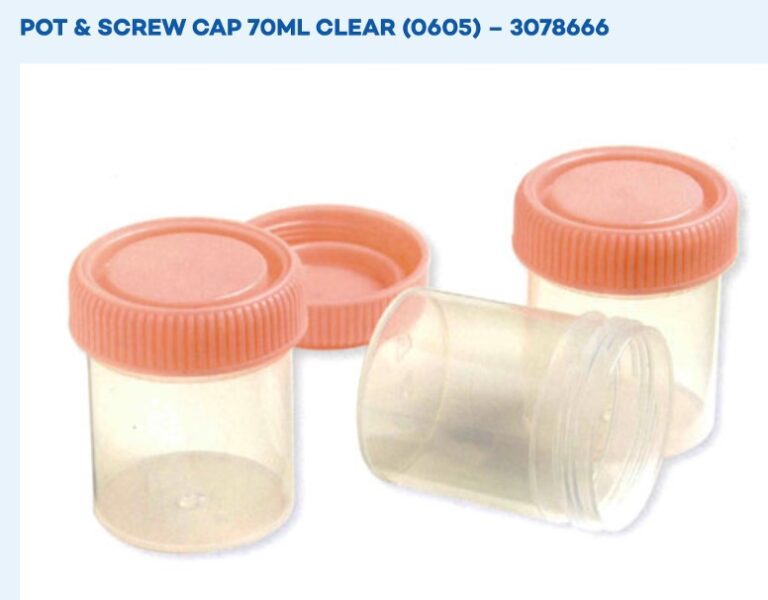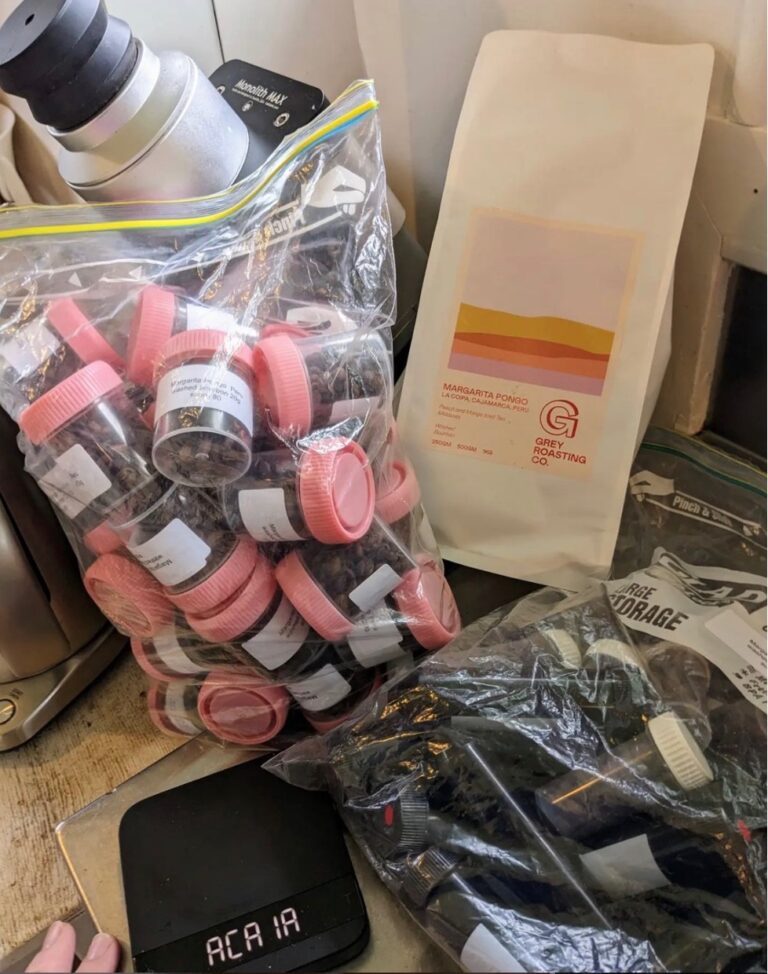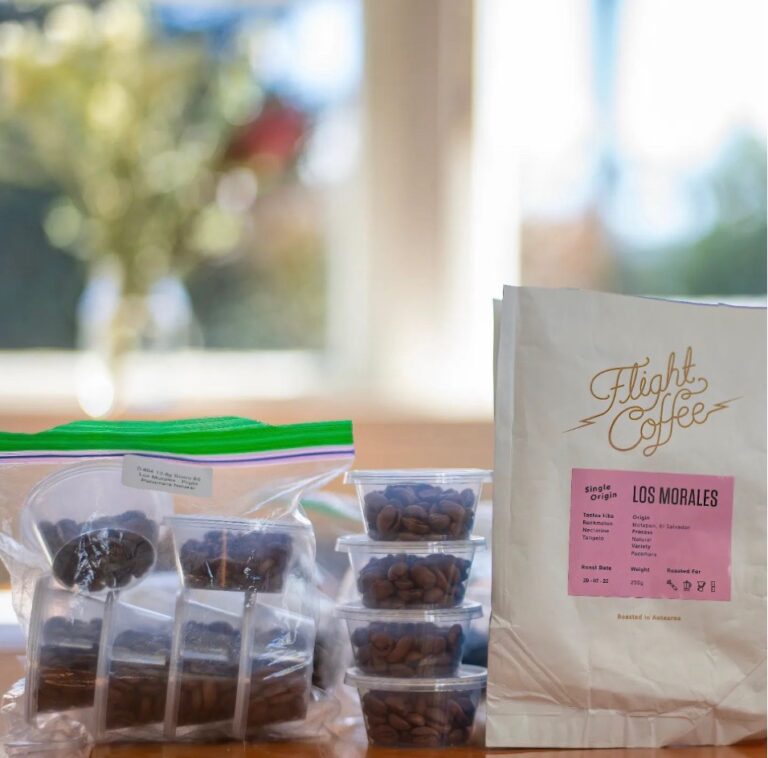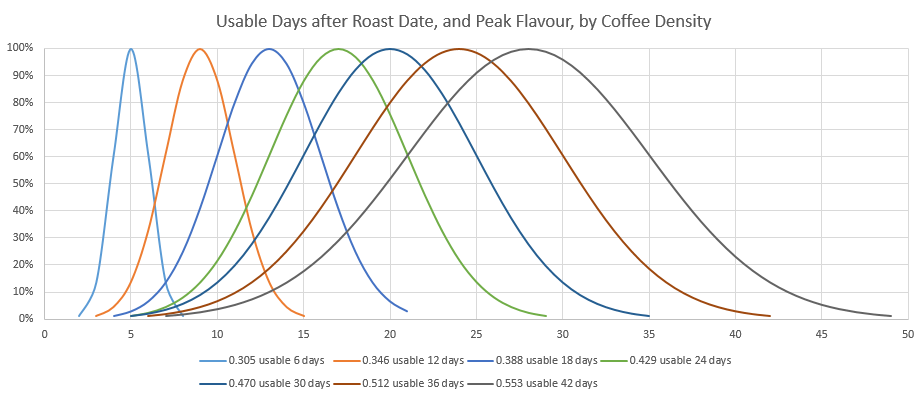How to store coffee beans - 9 tips
How to store coffee beans: these nine tips will improve your flavor and aroma—freezing after roasting quickly. Store in single-dose reusable containers and grind frozen.
Coffee storage tips:
- 70% of the aroma and taste is lost within ten days of roasting coffee
- The only way to slow staling is to freeze whole beans
- Freeze as soon after roasting as possible
- Do not Freeze in one large container
- Vacuum packaging is unnecessary and is bad for the environment
- Use small single-dose reusable sealed containers
- Resting after roasting is unnecessary
- Grind your coffee at home just before making your coffee
- Grinding frozen beans improves the uniformity of the grind. Do not defrost before grinding.
How to Store Coffee Beans for home users
70% of the aroma molecules are lost within ten days of storage of Freshly roasted whole-bean coffee, even in unopened poly-aluminum laminated bags equipped with a one-way valve, stored at room temperature.
A busy Cafe will easily completely use large 3kg bags in a few hours, which is why commercial grinders have large hoppers. But for the home user, who may only make 1 or 2 cups a day, a 250g bag may take a month to consume.
Changing how you store your coffee at home will improve your coffee because fresh coffee tastes better than old coffee.
The aroma and flavors are Volatile Organic Compounds (VOCs). These are rapidly lost by escaping with the diffusion of carbon dioxide from the beans out of the one-way valve.
Good quality bags reduce oxygen and moisture getting to the beans but don’t slow aroma, flavor, and freshness loss.
The only way to slow staling is to freeze whole beans because freezing slows kinetic reactions.
A 25°C difference in temperature decreases freshness loss by 100-fold.
At -20°C, a domestic freezer can keep coffee fresh for three months to a year.
Degassing continues in the freezer but at a much slower rate. Seventy days in the freezer is the same as two days out.
Storing whole-bean coffee in a freezer will significantly prolong freshness.
Top cafes worldwide are freezing coffee:
Proud Mary Chills Out – Why Nolan Hirte is Freezing Everything
2022 Is the Year We All Freeze Our Beans – Barista Magazine Online
How to Store Coffee Beans - Containers for Freezing Coffee
When you remove coffee from the freezer and open a container, the humidity will condense on the frozen coffee. Being hygroscopic, it will absorb moisture, which can be a worsening improvement and is why you can find people recommending against freezing coffee. Freezing one large container, opening and closing, and refreezing as you remove portions is not a good idea.
The recommended method is to freeze individual single doses shortly after roasting.
Vacuum packaging is unnecessary and is bad for the environment.
- Because oxidation stops at low temperatures, you do not need to store frozen coffee in an oxygen-free environment, such as vacuum packaging.
- Freezer burn is where water lost from food items during sublimation is redeposited on the food’s surface, and refrigeration cools as ice crystals. It impacts solids with a moisture content: meats, fish, fruit, and vegetables. The moisture loss means fruit and vegetables can become shriveled and dry, and meats develop a leathery texture and dark spots. The dehydration creates pockets in the food, which are then open to the air, accelerating oxidation. In fatty foods, this oxidation can cause unpleasant flavors. But roasted coffee is very dry, around 2% moisture content, as roasting vaporizes moisture content. Freezer burn is not an issue with roasted coffee. Another reason vacuum packaging is unnecessary.
Small reusable sealed containers are ideal.
For single espresso doses of 14-25gms, 70ml plastic screw top pots can be used.

For smaller filter doses of 11-15gm, 25ml lidded sauce pots can be used.

Ideally, get the coffee from the roaster, then single-dose and freeze it as soon as possible, on the same day, within hours if you can. Talk to your roaster about your requirements. They will be glad to help.
I’m lucky enough to have a fridge with a freezer at work. I arrange a day with the roaster. They usually roast it in the morning and have it bagged and ready for me to pick up on my way to work. I have the scales and storage pots with me. It only takes a few minutes to weigh the doses and put all the pots in a plastic bag in the freezer at work. I use a chiller bag and a frozen block to keep them cool on the train ride home.


It sounds like a lot of effort, but it is really not, and you get awesome, really fresh coffee for months from it.
How to Store Coffee Beans - Resting Period
There is a theory that coffee requires resting after roasting before use. This primarily comes down to the method of making the coffee. Immediately after roasting, a large volume of CO₂ diffuses from the roasted beans.
With filter methods such as V60, the bloom phase allows most of the CO₂ to escape as the water first hits the coffee, then a crust forms as CO₂ floats some grinds to the top of the brew. The crust can be broken and stirred into aid extraction.
A resting period is unnecessary to cope with excessive CO₂ for filter methods.
With espresso, the coffee is compressed in a Puck and has a much shorter contact time of 20-30 seconds with the water.
There is a theory that the excessive CO₂ of very freshly roasted coffee impedes the extraction process of espresso and leads to channeling and uneven extraction. The standard advice is to wait 3-4 days before use. As we know, much aroma and flavor would be unnecessarily lost with such a delay.
Some espresso machines are capable of pre-infusion, which is comparable to the bloom phase. A low 1-2 bar pressure wetting of the bed for a few seconds to allow degassing before ramping up to 9 bar for extraction.
Another method, if needed, is leaving up to 15 minutes between grinding and extraction. The increase in surface area allows the gas to escape at a much increased rate.
Using a naked portafilter and a mirror enables observation of signs of channeling, such as spurts. Examine the spent puck for signs of uneven extraction where there are light and dark patches.
Samo Smrke’s studies at the Coffee Excellence Center at Zurich University of Applied Sciences (ZHAW) found :
- Coffees with no resting time showed the slowest decline in score over time compared to rested coffees.
- Non-rested coffee lost quality slower than coffee rested before packaging, perhaps because fewer volatile compounds were lost before the coffee was protected.
- For maximum freshness, single dose package and freeze your coffee as soon as possible.
Perform your experiments for Freshness and Resting.
My test consisted of:
4 x 150g bags roasted in the same batch on Thursday, 3/8/2023, 8:30 am, initially packaged by Roaster (Mojo).
When secondary packaged single-dosed and frozen: | Results after ten days | |
Bag #1 | Day 0, 9:30 am 1 hr after roasting | Very good, sparkling, vibrant fruit notes with the toasted nutty notes. I would purchase more. Scored 75. |
Bag #2 | Day 3, Sunday 6/8/2023 9:30 am | The difference from bag #1 was still noticeable; immediately frozen was the best way to store coffee for freshness. Scored 72. |
Bag #3 | Day 7 Thursday 10/8/2023 | Scored 68. It’s not good enough to buy more. |
Bag #4 | Day 10 Sunday 13/8/2023 | OK, but I would not buy more of it. There is a night and day difference from #1, almost no fruit notes, flat, lifeless, toasted nutty notes, but pretty average. Scored 65. |
The results are it is a one-way street. The longer the coffee is out of the freezer, the worse the coffee is going to get.
I had no trouble with the extraction of #1 on my manual lever Flair 58, where I could control pre-infusion and the flow through the puck. Machines with pumps or heavy springs with less control could have issues.
It is the fruit flavors, and the acidity that are the first VOCs lost.
Some people indeed have a low tolerance for acidity in coffee. I’d rather manage this with roast levels than stale coffee.
Very lightly roasted coffee can have a green vegetal flavor, which does fade with staling. Staling is a tool to cope with roast flaws, but it’s pretty desperate.
My advice is to do your own tests and determine your preference.
In conclusion, I’ll try to get all my coffee from the roaster into the freezer as soon as possible.
How to Grind Frozen Coffee
Grind your coffee at home just before making your coffee.
After the coffee is ground, the off-gassing rate increases dramatically. Nearly 70% of the CO2 aroma and flavor is lost within one day of grinding. Do not buy pre-ground coffee.
The longer you have between grinding and brewing, the more aromatic flavors you lose.
Grinding frozen beans improves the uniformity of the grind. Do not defrost before grinding. See a study that coffee scientist Chris Hendon worked on in 2016 that explored grinding frozen coffee.
Consider reducing the time between grinding and making your espresso to the minimum.
The History of Coffee Freshness
When Alfred Peet opened the doors of his first coffee shop in Berkeley, CA, he quietly ignited a revolution that forever changed the expectations of coffee drinkers.
1955, Mr. Peet moved to San Francisco to work for a coffee importer. There, he was dismayed to discover that Americans were drinking inferior coffee. (“The History of Peet’s Coffee | Peet’s Coffee“) This inspired him to bring a new perspective on coffee to the United States.
“I came to the richest country in the world, so why are they drinking the lousiest coffee?” (“America’s ‘Lousy’ Coffee kickstarted Alfred Peet’s Empire”)
-ALFRED PEET
On April 1, 1966, Mr. Peet opened his coffee shop in Berkeley at the corner of Vine and Walnut streets, near the University of California campus.
To Mr. Peet, having the shortest distance possible between the roaster and the customer was crucial, underscoring the importance of freshness to flavor. He was committed to only using high-quality beans. He single-handedly helped the American consumer understand and appreciate freshly roasted, deeply satisfying craft coffee.
In 1971, three young entrepreneurs approached Mr. Peet to learn the finer points of the coffee business, and for two years, he provided them with training and roasted coffee beans for their new venture, a company called Starbucks.
Freshness is the difference between a unique sensory experience and a mediocre coffee.
How to Store Coffee - Chemistry
Dry green beans, if stored properly, can last over a year.
Roasting coffee changes its physical structure, creating volatile compounds that are physically off-gassed.
Staling factors are where coffee is degraded by oxygen temperature and moisture.
Loss of volatile aroma compounds and oxidation form new aroma compounds that impart off flavors.
Formation of Off-Flavors and Rancidity occurs even if coffee is stored under a vacuum or at low oxygen levels and can still show lipid oxidation due to the presence of free radicals in coffee produced during the roasting process.
Carbon dioxide could affect acidity in the cup: Released Co2 can react with water (H2O) to form an acid called carbonic acid (H2CO3), which can potentially increase the brew’s acidity. Consequently, fresh coffee with a higher CO2 content could tend to acidify the coffee.
The composition of the gas released from coffee during storage was analyzed to compose nearly nine-tenths CO2 (87 %), 7.3 % CO, and 5.3 % nitrogen (N), and the rest are VOCs – or aroma compounds. This composition may vary with coffee variety, roast degree, or roast profile used. When the coffee is ground, the off-gassing rate is enormously increased by up to a factor of ten.
The darker the roast degree, the more gasses are lost – and at a faster rate.
Use Arrhenius’ law to calculate the optimal freshness period by cooling coffee during storage.
Just one week after roasting, tasters have been shown to prefer coffee that had been stored frozen. Coffee stored one week after roasting at room temperature was “distinctly less odor-intensive” and showed “less aroma freshness.”
- Perceptive loss of quality would be evidenced over the first 7-10 days after roasting.
- Coffee rested before packaging will have lower cupping scores and stale at the same rate as non-rested coffees, having lost many volatiles and flavor compounds during prolonged exposure to air.
- Coffees with no resting time showed the slowest decline in score over time compared to rested coffees.
- Package your coffee as immediately as possible after cooling.
- Avoid buying too much coffee at one time.
Why coffee freshness matters
There is no substitute for FRESH roasted and freshly ground coffee.
Coffee has the most flavor when it is FRESH out of the roaster.
Freshly roasted coffee has several characteristics that distinguish it from stale coffee:
- Aroma: Freshly roasted coffee emits a strong and enticing aroma with distinct notes specific to its origin and roast profile.
- Flavor Complexity: It offers a wide range of flavors that are more pronounced, including fruity, floral, nutty, chocolaty, and more, depending on the coffee bean’s variety and origin.
- Acidity: Freshly roasted coffee has a bright and pleasant acidity, adding liveliness and a tangy taste to the brew.
- Body: It possesses a fuller body, resulting in a richer and more satisfying mouthfeel.
- Crema (Espresso-based): The crema on top of the shot in espresso-based coffee is thicker and creamier, indicating a fresh and well-extracted espresso.
- Vibrancy: Freshly roasted coffee exhibits liveliness and vibrancy in its taste profile, making it more enjoyable and flavourful.
Coffee that is not FRESH is bland, dull, flat, has hardly any aroma, and may be bitter. Lifeless, lacking in crema.
Fresh coffee has a vibrant aroma, lively fruity notes, and crisp acidity, producing a thick, creamy espresso crema.
Only fresh coffee will be able to produce that layer of crema.
Sources
Specialty Coffee Association (SCA) Coffee Freshness Handbook, research conducted by the Coffee Excellence Center at Zurich University of Applied Sciences (ZHAW), published in 2018.
Coffee Aging
Density.coffee used to provide a coffee aging table mathematically generated, based on the theory coffee can be too fresh and that, in some way, roasted coffee needs time to mature. Darker roasts, being much less dense, matured very quickly and had a short window of usability. Very light roasts took a lot longer and had a much wider window.
I no longer believe this advice to be true, but if you wish to continue to use it, the aging table is provided below:

| DENSITY | Optimum age (days) | Usable range +/- (days) |
|---|---|---|
| 0.478 | 28 | 7 |
| 0.477 | 28 | 7 |
| 0.476 | 28 | 7 |
| 0.475 | 28 | 7 |
| 0.474 | 27 | 7 |
| 0.473 | 27 | 7 |
| 0.472 | 27 | 7 |
| 0.471 | 27 | 7 |
| 0.470 | 27 | 7 |
| 0.469 | 27 | 7 |
| 0.468 | 27 | 7 |
| 0.467 | 26 | 7 |
| 0.466 | 26 | 7 |
| 0.465 | 26 | 7 |
| 0.464 | 26 | 6 |
| 0.463 | 26 | 6 |
| 0.462 | 26 | 6 |
| 0.461 | 26 | 6 |
| 0.460 | 25 | 6 |
| 0.459 | 25 | 6 |
| 0.458 | 25 | 6 |
| 0.457 | 25 | 6 |
| 0.456 | 25 | 6 |
| 0.455 | 25 | 6 |
| 0.454 | 24 | 6 |
| 0.453 | 24 | 6 |
| 0.452 | 24 | 6 |
| 0.451 | 24 | 6 |
| 0.450 | 24 | 6 |
| 0.449 | 24 | 6 |
| 0.448 | 24 | 6 |
| 0.447 | 23 | 6 |
| 0.446 | 23 | 6 |
| 0.445 | 23 | 6 |
| 0.444 | 23 | 6 |
| 0.443 | 23 | 6 |
| 0.442 | 23 | 6 |
| 0.441 | 23 | 6 |
| 0.440 | 22 | 6 |
| 0.439 | 22 | 6 |
| 0.438 | 22 | 5 |
| 0.437 | 22 | 5 |
| 0.436 | 22 | 5 |
| 0.435 | 22 | 5 |
| 0.434 | 22 | 5 |
| 0.433 | 21 | 5 |
| 0.432 | 21 | 5 |
| 0.431 | 21 | 5 |
| 0.430 | 21 | 5 |
| 0.429 | 21 | 5 |
| 0.428 | 21 | 5 |
| 0.427 | 21 | 5 |
| 0.426 | 20 | 5 |
| 0.425 | 20 | 5 |
| 0.424 | 20 | 5 |
| 0.423 | 20 | 5 |
| 0.422 | 20 | 5 |
| 0.421 | 20 | 5 |
| 0.420 | 20 | 5 |
| 0.419 | 19 | 5 |
| 0.418 | 19 | 5 |
| 0.417 | 19 | 5 |
| 0.416 | 19 | 5 |
| 0.415 | 19 | 5 |
| 0.414 | 19 | 5 |
| 0.413 | 18 | 5 |
| 0.412 | 18 | 4 |
| 0.411 | 18 | 4 |
| 0.410 | 18 | 4 |
| 0.409 | 18 | 4 |
| 0.408 | 18 | 4 |
| 0.407 | 18 | 4 |
| 0.406 | 17 | 4 |
| 0.405 | 17 | 4 |
| 0.404 | 17 | 4 |
| 0.403 | 17 | 4 |
| 0.402 | 17 | 4 |
| 0.401 | 17 | 4 |
| 0.400 | 17 | 4 |
| 0.399 | 16 | 4 |
| 0.398 | 16 | 4 |
| 0.397 | 16 | 4 |
| 0.396 | 16 | 4 |
| 0.395 | 16 | 4 |
| 0.394 | 16 | 4 |
| 0.393 | 16 | 4 |
| 0.392 | 15 | 4 |
| 0.391 | 15 | 4 |
| 0.390 | 15 | 4 |
| 0.389 | 15 | 4 |
| 0.388 | 15 | 4 |
| 0.387 | 15 | 4 |
| 0.386 | 15 | 3 |
| 0.385 | 14 | 3 |
| 0.384 | 14 | 3 |
| 0.383 | 14 | 3 |
| 0.382 | 14 | 3 |
| 0.381 | 14 | 3 |
| 0.380 | 14 | 3 |
| 0.379 | 13 | 3 |
| 0.378 | 13 | 3 |
| 0.377 | 13 | 3 |
| 0.376 | 13 | 3 |
| 0.375 | 13 | 3 |
| 0.374 | 13 | 3 |
| 0.373 | 13 | 3 |
| 0.372 | 12 | 3 |
| 0.371 | 12 | 3 |
| 0.370 | 12 | 3 |
| 0.369 | 12 | 3 |
| 0.368 | 12 | 3 |
| 0.367 | 12 | 3 |
| 0.366 | 12 | 3 |
| 0.365 | 11 | 3 |
| 0.364 | 11 | 3 |
| 0.363 | 11 | 3 |
| 0.362 | 11 | 3 |
| 0.361 | 11 | 3 |
| 0.360 | 11 | 2 |
| 0.359 | 11 | 2 |
| 0.358 | 10 | 2 |
| 0.357 | 10 | 2 |
| 0.356 | 10 | 2 |
| 0.355 | 10 | 2 |
| 0.354 | 10 | 2 |
| 0.353 | 10 | 2 |
| 0.352 | 10 | 2 |
| 0.351 | 9 | 2 |
| 0.350 | 9 | 2 |
| 0.349 | 9 | 2 |
| 0.348 | 9 | 2 |
| 0.347 | 9 | 2 |
| 0.346 | 9 | 2 |
| 0.345 | 9 | 2 |
| 0.344 | 8 | 2 |
| 0.343 | 8 | 2 |
| 0.342 | 8 | 2 |
| 0.341 | 8 | 2 |
| 0.340 | 8 | 2 |
| 0.339 | 8 | 2 |
| 0.338 | 7 | 2 |
| 0.337 | 7 | 2 |
| 0.336 | 7 | 2 |
| 0.335 | 7 | 2 |
| 0.334 | 7 | 1 |
| 0.333 | 7 | 1 |
| 0.332 | 7 | 1 |
| 0.331 | 6 | 1 |
| 0.330 | 6 | 1 |
| 0.329 | 6 | 1 |
| 0.328 | 6 | 1 |
| 0.327 | 6 | 1 |
| 0.326 | 6 | 1 |
| 0.325 | 6 | 1 |
| 0.324 | 5 | 1 |
| 0.323 | 5 | 1 |
| 0.322 | 5 | 1 |
| 0.321 | 5 | 1 |